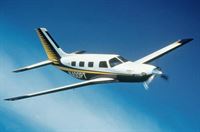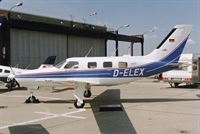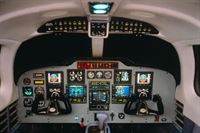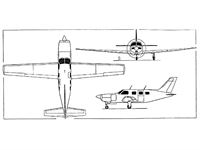
Варианты
- Piper - Malibu PA-46 / Matrix / Mirage / Meridian - 1982 - США
- Intracom - GM-17 Viper - 2003 - Швейцария
Piper PA-46 Malibu, Matrix, Mirage и Meridian
В конце 1982 года компания "Piper" заявила о намерении создать к концу следующего года новый одномоторный пассажирский поршневой самолет, впервые в мире оснащенный герметичной кабиной. Получившая обозначение PA-46-310P Malibu, эта машина имела убирающееся трехстоечное шасси и оснащалась двигателем Teledyne Continental TSIO-520-BE с турбонагнетателем. Ее герметичная кабина была рассчитана на пилота и пятерых пассажиров.
Сертификация завершилась в сентябре 1983 года, и до 1988 года было поставлено 404 самолета, после чего переключились на выпуск варианта PA-46-350P Malibu Mirage. Эта улучшенная модификация оснащалась ПД TIO-540-AE2A с турбонаддувом мощностью 350 л.с. (261 кВт),а ее вариант с усиленным крылом получил обозначение PA-46-500TP Malibu Meridian.
Этот самолет впервые взлетел в 1999 году и был оснащен ТВД PT6A-42A мощностью 1209 э.л.с. (901 кВт), дефорсированным до 400 э.л.с. (298 кВт). Meridian был сертифицирован в сентябре 2000 года, а первые поставки покупателям начались уже в ноябре.
В 2008 году появился самолет PA-46R-350T Matrix, ставший последним в этом семействе. Модель оказалось настолько удачной, что в первый год выпуска производство не успевало удовлетворять заказы. В последние годы продажи Meridian снова росли, например, в 2011 году было продано 32 самолета.
ТАКТИКО-ТЕХНИЧЕСКИЕ ХАРАКТЕРИСТИКИ
PA-46-310P Malibu
Тип: шестиместный моноплан
Силовая установка: один ПД Teledyne Continental TSIO-520-BE с турбонаддувом мощностью 310 л. с. (231 кВт)
Летные характеристики: максимальная скорость 435 км/ч; потолок 7620 м; максимальная дальность полета 2947 км
Масса: пустого 1032 кг; максимальная взлетная 1746 кг
Размеры: размах крыла 13,11 м; длина 8,66 м; высота 3,44 м; площадь крыла 16,26 м2
- Описание
Фотографии
-
Air Pictorial 1999-12 / R.Simpson - Business brisk at Atlanta
Регистрационный номер: N402MM [2] Piper is moving forward with the Malibu Meridian, and one of the four prototypes, N402MM, made the type’s debut at Atlanta, and is seen at Peachtree de Kalb Airport.
-
Jane's All the World Aircraft 2000 / 2-01 - AIRCRAFT - FIXED-WING - CIVIL
Регистрационный номер: N400PT [2] Prototype turboprop Piper Malibu Meridian (1999)
-
Мировая Авиация 216
Регистрационный номер: N402MM [2] В состав стандартного оснащения Malibu Meridian входят усовершенствованная современная "стеклянная" кабина и интегрированные навигационные системы.
-
Air International 2015-03 / News
Регистрационный номер: N4414Z [3] Piper’s new Meridian 500 features Garmin G1000 avionics and a range of safety improvements from previous Meridian variants.
-
Air International 2015-04 / D.Unwin - The New Meridian /Commercial/
Регистрационный номер: N4414Z [3] -
Air International 2015-04 / D.Unwin - The New Meridian /Commercial/
Регистрационный номер: N4414Z [3] -
Jane's All the World Aircraft 2000 / 2-01 - AIRCRAFT - FIXED-WING - CIVIL
Регистрационный номер: D-ELEX Piper PA-46-350P Malibu Mirage pressurised, single piston-engined aircraft (1999)
-
Air International 2019-11 / Backpages
Регистрационный номер: N504EZ [2] Piper PA-46 turboprop N504EZ is testing a hydrogen fuel cell powertrain that will be used for the Orkney flight.
-
Air International 2020-08 / Focus: UAV, Rotary, Business, Technology
Регистрационный номер: N504EZ [2] ZeroAvia’s HyFlyer is a modified Piper M-class aircraft which can employ a hybrid hydrogen/electric powertrain.
-
Air International 2021-03 / M.Broadbent - Together in electric dreams
Personnel involved with hydrogen aircraft will need extra training to learn about the differences in operating them
-
Air International 2021-03 / M.Broadbent - Together in electric dreams
Регистрационный номер: G-HYZA [4], N866LP [4] Refuelling with the conventional set-up of a vehicle coming to the aircraft was used in the 2020 test
-
Air International 2021-03 / M.Broadbent - Together in electric dreams
Регистрационный номер: N866LP [4], G-HYZA [4] ZeroAvia used Piper M350 N866LP (c/n 4636130), re-registered G-HYZA, for flight tests but plans to move to a small turboprop airliner
-
Air International 2021-02 / Focus: UAV, Rotary, Business, Technology, GA
Регистрационный номер: G-HYZA [4], N866LP [4] ZeroAvia’s modified Piper PA-46-350P Malibu Mirage executive aircraft, G-HYZA, taking off from Cranfield Airfield in Bedfordshire on September 24, 2020 to conduct the world's first ever hydrogen fuel cell-powered flight of a commercial-grade aircraft
-
Air International 2021-05 / T.Craig - Fuel for thought
Регистрационный номер: G-HYZA [4], N866LP [4] ZeroAvia carried out its test flights in a Piper Malibu Mirage turboprop modified with a 300kW battery electric power system along with a customised cockpit display and computer
-
Air International 2015-04 / D.Unwin - The New Meridian /Commercial/
Регистрационный номер: N4416P [7] Seen from this side profile, there is a row of vortex generators on the wing, just aft of the pneumatic de-icing boot.
-
Air Pictorial 1999-11
Регистрационный номер: N400PT [2] Based on the Malibu Mirage, the latest Piper Malibu Meridian single-turboprop business aircraft is considerably different with a marked increase in performance and updated avionics and systems. The PT6A-42A replaces the earlier Teledyne Continental TIO-540 and the wing and tail have been redesigned. In the pressurised interior, the cockpit has the latest colour displays with information presented in analogue and digital format, a Garmin GNS-530 comms/nav system and a GPS. The first of four prototypes flew in August 1998 with the last flying in September 1999. US certification and first deliveries are due in July 2000 and production is currently planned to run at around 30-40 aircraft per year.
-
Jane's All the World Aircraft 2000 / 2-01 - AIRCRAFT - FIXED-WING - CIVIL
Piper Malibu Meridian EFIS instrument panel (1999)
-
Air International 2015-04 / D.Unwin - The New Meridian /Commercial/
Регистрационный номер: N4416P [7] To ensure the cockpit is as clutter-free as possible many of the switched are in a neat overhead panel.
-
Air International 2020-04 / D.Unwin - Are You Ready For a Robot? /At the Controls/
[Piper M600] Technology takeover? Autoland active is clearly shown on all three screens in this cockpit shot.
-
Air International 2015-04 / D.Unwin - The New Meridian /Commercial/
Регистрационный номер: N4416P [7] The Aspen Avionics EFD-1000 ‘Evolution’ standby instrument is entirely self-contained and provides airspeed, altitude, attitude and navigation information.
-
Air International 2015-04 / D.Unwin - The New Meridian /Commercial/
Регистрационный номер: N4416P [7] The ‘LVL’ button on the instrument panel automatically engages the autopilot and returns the aircraft to straight and level flight.
-
Air International 2015-04 / D.Unwin - The New Meridian /Commercial/
Регистрационный номер: N4416P [7] The throttle incorporates a Take Off Go Around (TOGA) button. When pressed, it disengages the autopilot (the yaw damper remains engaged) and moves the flight director command bars to an 8 degrees nose up, wings level attitude.
-
Air International 2015-04 / D.Unwin - The New Meridian /Commercial/
Регистрационный номер: N4416P [7] The multi-function display shows a large amount of navigation and systems information, but surprisingly it doesn’t currently have an electronic checklist.
-
Air International 2015-04 / D.Unwin - The New Meridian /Commercial/
Регистрационный номер: N4416P [7] The cabin has wide leather seats, individual air vents and reading lights. Four passengers can be accommodated in club-style seating, with the fifth in the co-pilot's seat.
-
Air Pictorial 1999-11
Piper Malibu Meridian
-
Jane's All the World Aircraft 2000 / 2-01 - AIRCRAFT - FIXED-WING - CIVIL
Piper PA-46-350P Malibu Mirage (Textron Lycoming TIO-540-AE2A) (1990)
- Фотографии

























